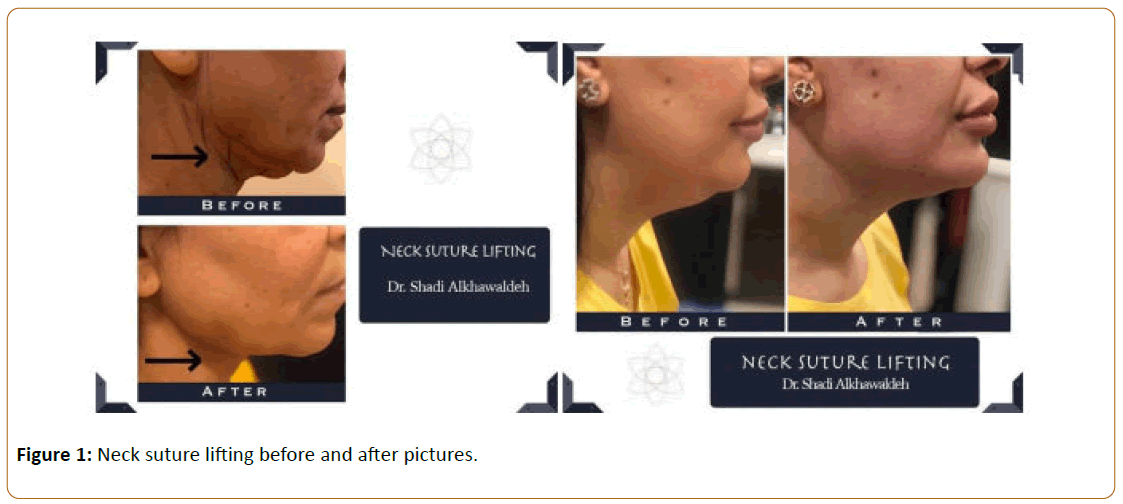Al-Khawaldeh S*
Medicines San Frontiers (MSF), Jordan
- Corresponding Author:
- Shadi Al-Khawaldeh
Dermatologist, Skin Surgeon and Laser Specialist
Plastic Surgeon Assistant at Medicines San Frontiers, Jordan
Tel: +962797439162
E-mail: skhawaldah@hotmail.com
Received Date: May 24, 2020; Accepted Date: July 23, 2020; Published Date: July 30, 2020
Citation: Al-Khawaldeh S (2020) Face Lifting by Suspension Sutures. J Univer Surg. Vol.8 No.3: 7. doi:10.36648/2254-67az58.8.3.126
Keywords
Face lifting; Suspension; Sutures; Surgery; Superficial Muscular Aponeurotic System (SMAS)
Introduction
The SMAS rhytidectomy, also known as an SMAS facelift, is a surgical procedure that targets the lower two-thirds of the face. It is performed to address sagging skin, excess fat, jowls, and loss of volume in the cheeks. It is less invasive than a regular facelift, which targets the superficial skin of the face, and recuperation is faster. The SMAS (Superficial Muscular Aponeurotic System) is a layer of tissue deep within the skin and subcutaneous tissue. It is one of the most important support structures for the face. The manipulation of this anatomic structure changes the appearance of the face.
An SMAS facelift counteracts the signs of aging by tightening the muscle, removing fat and trimming excess skin. An SMAS facelift is effective in correcting the following:
• Sagging in the midface
• Hollow cheeks
• Nasolabial folds
• Jowls
• Sagging fat
• Loose skin and fat under the chin and jawline
A facelift may remove or reduce the signs of aging but, over time, they will gradually reappear.
Methodology
We start with six points puncture, a temporal puncture just above the helix with dissection deep to the deep temporal fascia, the second puncture point is located at the fold of the ear lope, those two puncture points will give us the access to lift the lower face, neck and most importantly the jowls which is an obstacle in face lift procedure, from the second point we do our blind superficial dissection upwardly through the preauricular fascia then over the masseteric fascia then forward through the masseteric returing ligament reaching the premassetric space then we dissect a little bit inferiorly and superficially over the mandibular angle to get an access to the platysmal muscle. During that dissection we have to take care of a dangerous zone that is located in front of massetric fascia and the imaginary line which extends from the tragus to the angle of the mouth m since the buccal and the zygomatic branch of facial nerve tend to be superficial at that zone merging through massetric returing ligament and I will give an important concern to the marginal mandibular branch which passes over the mandible just anterior to the massetric muscle. A two sutures are tight to the deep temporal fascia just above the helix at the site of the first puncture then the first one passes downward to the level of mandibular angle with a straight needle to catch to catch the platysmal band aand return back to the first puncturing point and tight the suspension mimicking the MACS procedure, the second suture which was fixed to the deep temporal fascia is proceed obliquely forward at the angle about 30 degree to our suspension to reach the premassetric space and the jowls by a straight needle then backward to the deep temporal fascia and tight there (we used 20 proline suture).
For the mid face lifting, 4 punctures are done, the first one at the tip of the zygoma with a little bit of dissection to reach the periosteum which is going to be our second fixation point. then three punctures are done at the mid cheek representing equivalent triangle then by a straight needle, a deep bite is taken at tip of zygoma (second fixation point) deep to the periosteum then proceeding to the first mid check puncture then returing back to the fixation point and tight over then with the same suture we proceed the second point and back to the fixation point and tight it again then to the third point and tight again (when we proceed from the fixation point to the mid check point we proceed in a deep plane and return back subcutaneously using 30 proline suture). Figure 1 illustrates before/after pictures of our patients [1,2].

Figure 1: Neck suture lifting before and after pictures.
Discussion and Conclusion
It is a very efficient procedure in the age groups from 35-50, can be done under local anaesthesia, less bruising and swelling, no chance of flap necrosis which might happened in classical face lift, less down time to the patient, we avoid passing the dangerous zone at the temporal area where the frontal branch of facial nerve is located normally. On the other hand, the disadvantages are that this procedure does not fit older age group with saggy skin; there is no vertical lifting to the facial structures.
28690
References






